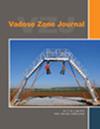原位铸锡结合三维扫描仪量化奇异蚯蚓洞
IF 2.5
3区 地球科学
Q3 ENVIRONMENTAL SCIENCES
引用次数: 2
摘要
蚯蚓(Lumbricus terrestris)在土壤生态系统中起着重要作用。分析蚯蚓地穴的空间结构对于了解地穴对水流和溶质运移的影响具有重要意义。本研究旨在利用新型原位铸锡法与三维激光扫描技术相结合的方法,定量表征不同耕作方式(陆园免耕和商庄旋转耕)土壤表面开放连接的蚯蚓洞的结构特征(横截面积[A]、圆度[C]、直径[D]、实际长度[Lt]、弯曲度[τ])。交叉检测部分anecic蚯蚓洞穴几乎是圆形,和C值D和A .统计学有显著负相关τ值没有明显差异(1.143±0.082和1.133±0.108)的anecic蚯蚓洞在LY和深圳,但D(6.456±1.585毫米)和(36.929±21.656平方毫米)anecic蚯蚓洞在LY明显大于D(3.449±0.531毫米)和(9.786±2.885平方毫米)在深圳。我们的研究表明,两个不同地点的洞穴结构彼此不同。两个地点的土壤耕作方式、土壤质地和土壤有机质含量都可能影响蚯蚓的种类组成、蚯蚓大小的变化和蚯蚓洞的形态。本研究中使用的方法使我们能够在有限的预算下充分评估野外anecic蚯蚓洞穴的空间结构。本文章由计算机程序翻译,如有差异,请以英文原文为准。
In‐situ tin casting combined with three‐dimensional scanner to quantify anecic earthworm burrows
Earthworms (Lumbricus terrestris) play a critical role in soil ecosystems. Analyzing the spatial structure of earthworm burrows is important to understand their effect on water flow and solute transport. The aim of this study was to quantitatively characterize structural characteristics (cross‐sectional area [A], circularity [C], diameter [D], actual length [Lt], tortuosity [τ]) of anecic earthworm burrows that were open and connected at the soil surface at two sites of different tillage treatments (no‐till at Lu Yuan [LY] and rotary tillage at Shang Zhuang [SZ]) by combining a new in‐situ tin casting method with three‐dimensional (3D) laser scanning technology. The cross‐sections of anecic earthworm burrows were almost circular, and the C values were significantly negatively correlated with D and A. Statistically, there were no significant differences in the τ values (1.143 ± 0.082 vs. 1.133 ± 0.108) of anecic earthworm burrows at LY and SZ, but D (6.456 ± 1.585 mm) and A (36.929 ± 21.656 mm2) of anecic earthworm burrows at LY were significantly larger than D (3.449 ± 0.531 mm) and A (9.786 ± 2.885 mm2) at SZ. Our study showed that burrow structures at two different sites differed from each other. Soil tillage methods, soil texture, and soil organic matter content at the two sites could have affected earthworm species composition, variation of earthworm size and the morphology of burrows. The method used in this research enabled us to adequately assess the spatial structure of anecic earthworm burrows in the field with a limited budget.
求助全文
通过发布文献求助,成功后即可免费获取论文全文。
去求助
来源期刊

Vadose Zone Journal
环境科学-环境科学
CiteScore
5.60
自引率
7.10%
发文量
61
审稿时长
3.8 months
期刊介绍:
Vadose Zone Journal is a unique publication outlet for interdisciplinary research and assessment of the vadose zone, the portion of the Critical Zone that comprises the Earth’s critical living surface down to groundwater. It is a peer-reviewed, international journal publishing reviews, original research, and special sections across a wide range of disciplines. Vadose Zone Journal reports fundamental and applied research from disciplinary and multidisciplinary investigations, including assessment and policy analyses, of the mostly unsaturated zone between the soil surface and the groundwater table. The goal is to disseminate information to facilitate science-based decision-making and sustainable management of the vadose zone. Examples of topic areas suitable for VZJ are variably saturated fluid flow, heat and solute transport in granular and fractured media, flow processes in the capillary fringe at or near the water table, water table management, regional and global climate change impacts on the vadose zone, carbon sequestration, design and performance of waste disposal facilities, long-term stewardship of contaminated sites in the vadose zone, biogeochemical transformation processes, microbial processes in shallow and deep formations, bioremediation, and the fate and transport of radionuclides, inorganic and organic chemicals, colloids, viruses, and microorganisms. Articles in VZJ also address yet-to-be-resolved issues, such as how to quantify heterogeneity of subsurface processes and properties, and how to couple physical, chemical, and biological processes across a range of spatial scales from the molecular to the global.
 求助内容:
求助内容: 应助结果提醒方式:
应助结果提醒方式:


